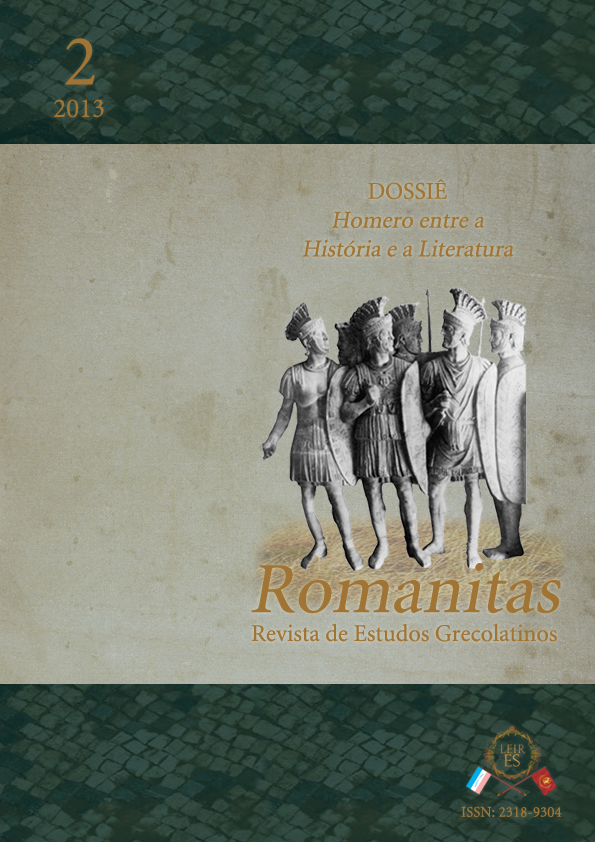O ideal de 'kalokagathia' em Xenofonte: uma análise dos excessos
DOI:
https://doi.org/10.17648/rom.v0i2.7419Palavras-chave:
Kalokagathia, Xenofonte, BanqueteResumo
Xenofonte, polígrafo ateniense que viveu no século V a.C., produziu um diálogo intitulado Banquete que possui como fio condutor as ações dos homens virtuosos, ou seja, dos kaloikagathoi. Nosso objetivo é identificar o que para Xenofonte consistia a kalokagathia a partir da análise de dois personagens do Banquete que se constituem em paradigmas de excesso: Nicerato e Critóbulo.Downloads
Referências
Documentação primária impressa
ARISTOTE. Poétique. Traduction de J. Hardy. Paris: Les Belles Lettres, 1995.
DIODORUS SICULUS. Library of History. Translation of C. H. Oldfather. Cambridge: Harvard University Press, 1989. v. VI.
DIOGENES LAERTIUS. Lives of Eminent Philosophers. Translation of Robert Drew Hicks. Cambridge: Harvard University Press, 1925. v. 1 (Books I-V).
DIOGENES LAERTIUS. Lives of Eminent Philosophers. Translation of Robert Drew Hicks. Cambridge: Harvard University Press, 1925. v. 2 (Books VI-X).
PLATON. Ménexène – Euthydème. Traduction de L. Méridier. Paris: Les Belles Lettres, 2002.
PLATON. Le Banquet. Traduction de Léon Robin. Paris: Les Belles Lettres, 1951.
PLATON. La République. Traduction de Émile Chambry. Paris: Belles Lettres, 1949.
THUCYDIDE. La Guerre du Péloponnèse. Tome III: Livres IV-V. Traduction de L. Bodin e J. de Romilly. Paris: Les Belles Lettres, 1968.
XENOFONTE. Banquete: Apologia de Sócrates. Tradução de Ana Elias Pinheiro. Coimbra: Centro de Estudos Clássicos e Humanísticos, 2008, p. 13-26.
XENOPHON. Memorabilia. Oeconomicus. Symposium. Apology. Translation of E. C. Marchant and O. J. Todd Cambridge: Harvard University Press, 1997.
Obras de apoio
AMIRALIAN, M. L. T. M. Compreendendo o cego: uma visão psicanalítica da cegueira por meios de desenhos-estórias. São Paulo: Casa do Psicólogo, 1997.
BOWDER, D. Quem foi quem na Grécia Antiga. São Paulo: Círculo do Livro, 1982.
COBET, C. G. Commentatio, qua continetur prosopographia Xenophontea. Leiden: Samuel et Joannem Luchtmans, 1836. Disponível em: http://bit.ly/PS9pmf [Acessado em 31/08/2012].
FLORENZANO, M. B. B. Nascer, Viver e Morrer na Grécia Antiga. São Paulo: Atual, 2004.
GARCÍA GUAL, C. Introducción. In: JENOFONTE. Anábasis. Traducción de Ramón Bach Pellicer. Madrid: Gredos, 2001, p.7-37.
GRIMAL, P. Dicionário da mitologia grega e romana. Rio de Janeiro: Bertrand Brasil, 1992.
LESKY, A. História da Literatura Grega. Lisboa: Fundação Calouste Gulbenkian, 1995.
PINHEIRO, A. E. Introdução. In: XENOFONTE. Banquete. Tradução de Ana Elias Pinheiro. Coimbra: Centro de Estudos Clássicos e Humanísticos, 2008, p. 13-26.
ROBB, K. Asebeia and Sunousia. The issues behind the indictment of Socrates. In: PRESS, G. A. Plato's Dialogues: new studies and interpretations. Boston: Rowman & Littlefield, 1993, p. 77-106.
VELA TEJADA, J. Empeireía y socratismo em los opuscula de Jenofonte. In: IBÁÑEZ, J-Mª N. (Org.). Lógos Hellenikós: homenaje al Professor Gaspar Morocho Gayo. León: Universidad de León, 2003, p. 455-464.
Downloads
Publicado
Como Citar
Edição
Seção
Licença
Copyright (c) 2014 Romanitas - Revista de Estudos Grecolatinos

Este trabalho está licenciado sob uma licença Creative Commons Attribution-NonCommercial-NoDerivatives 4.0 International License.
a. Os autores mantêm os direitos autorais e concedem à revista o direito de primeira publicação.
b. Os autores têm autorização para assumir contratos adicionais separadamente, para distribuição não-exclusiva da versão do trabalho publicada nesta revista (ex.: publicar em repositório institucional ou como capítulo de livro), com reconhecimento de autoria e publicação inicial nesta revista.
c. Autores têm permissão e são estimulados a publicar e distribuir seu trabalho online (ex.: em repositórios institucionais ou na sua página pessoal) após a primeira publicação pela revista, com os devidos créditos.
d. Os textos da revista estão licenciados com uma Licença CC BY 4.0 Deed Atribuição 4.0 Internacional (CC BY).




























